|

by Cheyenne Macdonald
29 November 2016
from
Dailymail Website
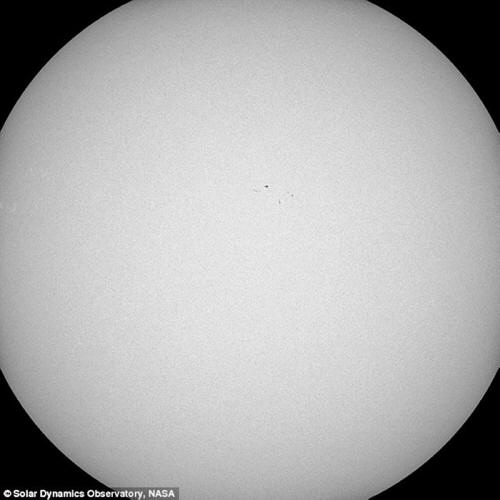
Images
captured by NASA's Solar Dynamics Observatory
from Nov 14-18 reveal
just a handful of barely-visible spots
on the surface of the
sun, which is otherwise as blank as a cue ball
The sun is
the most critical determinant of terrestrial
weather, and the lack of sun spots explains the
rapid cooling over the last several months.
If sun
spots, or solar storms, do not resume soon, the
cooling trend will continue.
Source
The 'Dead Sun'
Stunning NASA video reveals barren solar surface
with lowest level of activity since 2011
Footage from NASA Solar
Dynamics Observatory show nearly spotless sun.
The space agency says the sun hit its lowest activity level since
2011.
Sun follows a pendulum-like 11-year cycle of activity, and peaked in
2014.
While this is not unusual, some say trend could send us into 'mini
ice age'.
The face of the sun was nearly spotless
this month as our star marches toward solar minimum, hitting its
lowest activity level since 2011.
Images captured by NASA's Solar Dynamics Observatory (SDO)
from Nov 14-18 reveal just a handful of barely-visible spots on the
surface of the sun, which is otherwise as blank as a cue ball.
The sun follows a pendulum-like pattern of activity over roughly an
11-year period, and while scientists say this behavior is not
unusual, some have warned the current trend could send Earth into a
'mini ice age.'
According to NASA, the number of
sunspots appears to be dwindling faster than expected. But,
following the last activity peak in early 2014, they say the solar
minimum shouldn't come until 2021.
The researchers say they expect to see more, and larger, sunspots in
the time between - but, only time will tell.
THE SOLAR CYCLE
Conventional wisdom holds that solar activity swings back and
forth like a simple pendulum.
At one end of
the cycle, there is a quiet
time with few sunspots and flares. At the other end, solar max
brings high sunspot numbers and frequent solar storms.
It's a regular rhythm that repeats every 11 years. Reality is
more complicated.
Astronomers have been counting sunspots for centuries, and they
have seen that the solar cycle is not perfectly regular.
We're currently in
Cycle 24, which began in 2008.
In late June, it was revealed that the sun had entered the quietest
period for more than a century.
Vencore Weather claimed the sun had gone into 'cue-ball' mode
for the second time that month, with images from NASA showing no
large visible sunspots on its surface.
We've had the smallest number of sunspots in this cycle since Cycle
14, which reached its maximum in February of 1906.
On June 4th,
the sun went completely spotless and activity remained low for
around four days.
This follows another period of inactivity in February when another
image of NASA showed the sun in 'cue-ball mode'.
'The blank sun is a sign that the
next solar minimum is approaching and there will be an
increasing number of spotless days over the next few years,'
wrote Vencore Weather.
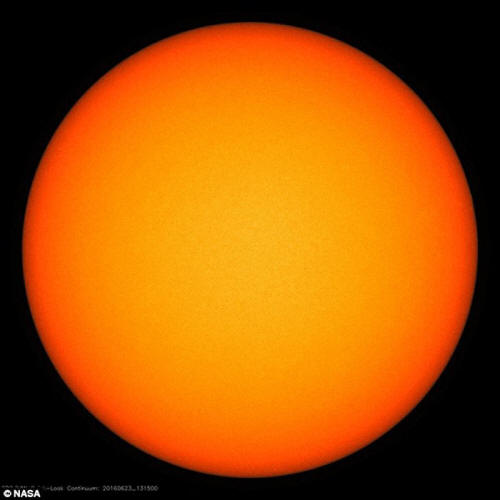
The sun is in
the currently in
its quietest period
for more than a century.
For the second time
this month,
the sun has gone into
'cue ball' mode,
with images from NASA
showing
no large visible
sunspots on its surface
The previous solar cycle,
Solar Cycle 23, peaked in 2000-2002 with
many furious solar storms.
During
Solar Max, huge sunspots and intense solar flares are a daily
occurrence. Auroras appear in Florida. Radiation storms knock out
satellites. The last such episode took place in the years around
2000-2001.
During
Solar Minimum, the opposite occurs. Solar flares are almost
non-existent while whole weeks go by without a single, tiny sunspot
to break the monotony of the blank sun. This is what we are
experiencing now.
The longest minimum on record,
the Maunder Minimum of 1645-1715,
lasted an incredible 70 years.
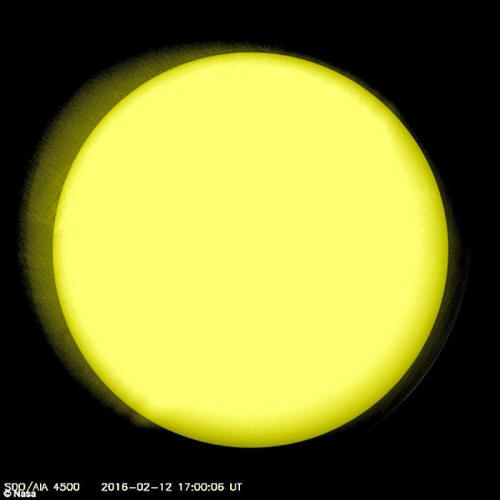
The sun is in
the midst of its quietest period
in more than a
century.
In February, it was
in 'cue ball' mode,
with an incredible
image from NASA
showing no large
visible sunspots seen on its surface
THE MAUNDER MINIMUM

The
Maunder Minimum (also known as the prolonged sunspot
minimum) is the name used for the period starting in about 1645
and continuing to about 1715 when sunspots became exceedingly
rare, as noted by solar observers of the time.
It caused London's River Thames to freeze over, and 'frost
fairs' became popular.
This period of solar inactivity also corresponds to a climatic
period called the 'Little Ice Age' when rivers that are normally
ice-free froze and snow fields remained year-round at lower
altitudes.
There is evidence that the Sun has had similar periods of
inactivity in the more distant past, NASA says.
The connection between solar activity and terrestrial climate is
an area of on-going research. Some scientists hypothesize that
the dense wood used in Stradivarius instruments was caused by
slow tree growth during the cooler period.
Instrument maker Antonio Stradivari was born a year before the
start of the Maunder Minimum.
During this period, sunspots were rarely observed and the solar
cycle seemed to have broken down completely.
The period of quiet coincided with the Little Ice Age, a series of
extraordinarily bitter winters in Earth's northern hemisphere.
Many researchers are convinced that low solar activity, acting in
concert with increased volcanism and possible changes in ocean
current patterns, played a role in that 17th century cooling.
A study last year claimed to have cracked predicting solar cycles -
and says that between 2020 and 2030 solar cycles will cancel each
other out. This, they say, will lead to another 'Maunder minimum' -
which has previously been known as a mini ice age when it hit
between 1646 and 1715.
The model of the sun's solar cycle produced unprecedentedly accurate
predictions of irregularities within the sun's 11-year heartbeat.
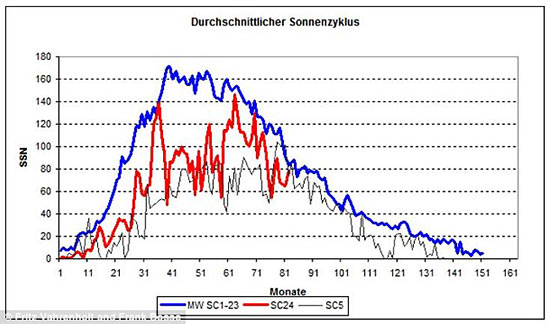
Show here is a
plot of
the monthly sunspot
number so far
for the current cycle
(red line)
compared to the mean
solar cycle (blue line)
and the similar solar
cycle no. 5 (black)
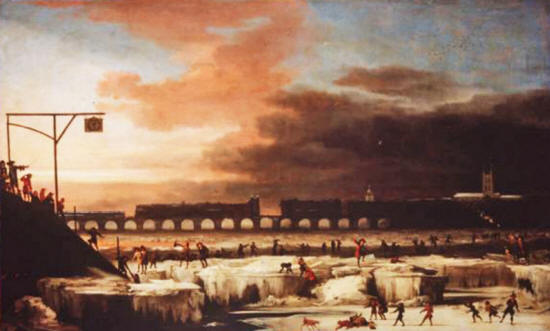
The
Frozen Thames, 1677
- an oil
painting by Abraham Hondius
shows the old
London Bridge during the Maunder Minimum
It draws on dynamo effects in two layers of the sun, one close to
the surface and one deep within its convection zone.
Predictions from the model suggest that solar activity will fall by
60 per cent during the 2030s to conditions last seen during the
'mini ice age' that began in 1645, according to the results
presented by Professor Valentina Zharkova at the National
Astronomy Meeting in Llandudno.
The model predicts that the pair of waves become increasingly offset
during
Cycle 25, which peaks in 2022.
During
Cycle 26, which covers the decade from 2030-2040, the two
waves will become exactly out of synch and this will cause a
significant reduction in solar activity.
'In cycle 26, the two waves exactly
mirror each other - peaking at the same time but in opposite
hemispheres of the Sun,' said Zharkova.
'Their interaction will be disruptive, or they will nearly
cancel each other.
'We predict that this will lead to the properties of a 'Maunder
minimum'.
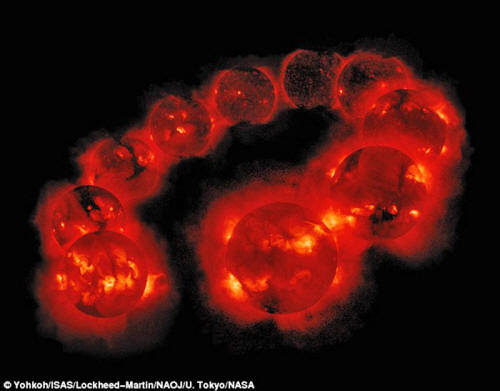
Montage of
images of solar activity
between August 1991
and September 2001
taken by the Yohkoh
Soft X-ray Telescope,
showing variation in
solar activity during a sunspot cycle
Video
- GET READY -
RECORD COLD COMING TO 'ALMOST ENTIRE USA'.
LOW TEMPERATURE RECORDS SET TO BE SHATTERED.
|








